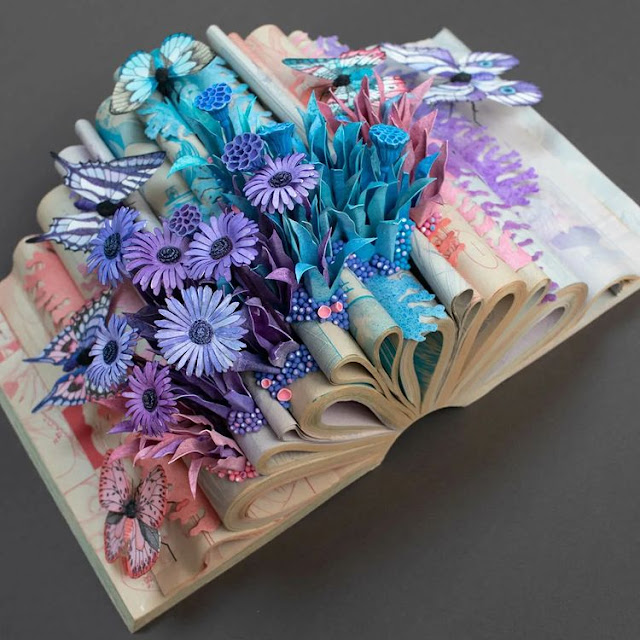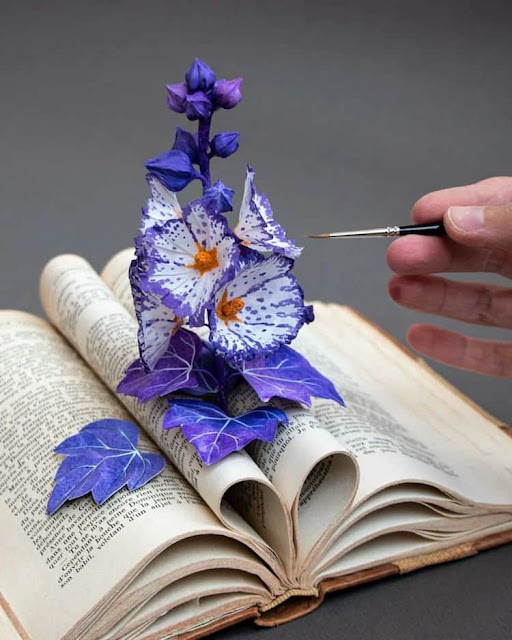Stéphanie Kilgast creates sculptures that
reflect the relationship between humanity and nature.
From empty plastic bottles and old earphones, jam jars, old cameras to
soda cans, anything you throw away as trash, Stéphanie Kilgast upcycles them
into vibrant artworks with her creativity and skills.
Through her work, the French artist hopes to highlight how our consumer
habits are destroying the environment. She uses polymer clay to create
nature-inspired forms sprouting from the found objects.
In an artist statement on her website, she describes her work as “an ode
to life, where plants and fungi meet insects, animals and minerals. These
encounters are growing in a colorful swirl of diversity, and the erratic growth
develops on found objects, in a dialogue between humanity and nature.”
Since 2017, in her series “Discarded Objects”, she has been growing
colorful organic sculptures on human-made objects, celebrating the beauty of
nature in a dialogue with humanity, questioning the lost balance between human
activities and nature. She believes humans are a part of nature, which they
often like to forget, creating an artificial barrier of tar between them and
the mud.
"Unfortunately, by destroying our environment so radically, we are
destroying ourselves. It is up to us to find an equilibrium between our
activities, and our desire to thrive intellectually and culturally, without
completely eradicating our very home.
With my choice of bold and vibrant colors, I offer a cheerful
post-apocalyptic world. While I talk about a heavy subject, the disastrous
impact of human activities, I also wish that people leave my work with a
feeling of happiness and hope, and keep fighting."- she added.
By using cast-off items, Kilgast invites the viewers to reflect on the
way people discard their belongings. At the same time, her art series also
highlights the splendor and strength of Earth's biodiversity.
Using modeling clays onto trash or thrifted objects, ink and watercolor,
or paint, she imagines a wild encounter of natural forms and bright colors onto
human-made objects.
Stéphanie is a supremely talented artisan who skillfully creates all the
amazing miniature food sculptures at PetitPlat (Name of her shop or business). She creates
coloured crystals, mushrooms, beetles, and abstract forms on the everyday
objects that are collected by her from thrift stores and trash cans. Her
detailed-oriented creations are the result of her hours of practice while
creating hyper realistic miniature food. Using polymer clay and similar hand
tools that she used to create miniature food, she now forms attractive
corals-like sculptures.
Stéphanie’s meticulously crafted truly splendid banquet of French
pastries, breads, cookies, fruits, cakes and candies.
Often, Kilgast explains, an idea will strike depending on the kinds of
objects that she might pick up from the trash, or from the thrift store:
"As I like to juxtapose objects and natural growth, the objects I
pick often inform the general direction I will go."
She was born in Frankfurt, Germany speaks fluent French, English, and
German and has a Master’s degree in Architecture. While on summer break in
2007, a bored Stephanie looking for a new hobby discovered the world of
miniatures and hasn’t looked back since.
Her work has been featured in international publications such as the New York Times, The Telegraph, BBC Brasil, Europa and American Miniaturist, she also exhibited her work in Hong Kong, North America, Asia, Australia and Europe.
- Some of Kilgast's more popular works focus on threatened species, like
this piece that features a mother polar bear and her cub, their bright white
fur standing in contrast to the vivid colors of the fungi beside them.
- Some of these juxtapositions can be delightfully surprising, such as
this brilliant pairing of a songbird and a set of abandoned headphones that are
now covered in colorful leaves, flower buds, fungi, and barnacles—all vibrantly
hued.
- Another charming sculpture has a miniature family of elephants grouped
on top of a reused plastic canteen, surrounded by tall fungi.
- She repurposes discarded novels in mixed-media artworks.
Kilgast, who is based in France, often documents her creative process in
videos on Instagram, YouTube, and Facebook. In addition to sharing her work
with her large online audience, the artist exhibits widely, and was a part of
the themed group show “Monochrome” at Art Number 23 in 2018, in London.





























0 Comments